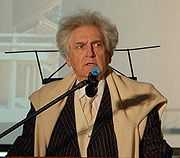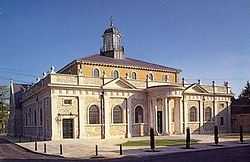Léon Krier
| Léon Krier | |
|---|---|
|
Léon Krier at the Old Town Forum of Frankfurt, Germany, in 2007 | |
| Born |
April 7, 1946 City of Luxembourg, Luxembourg |
| Occupation | Architect |
| Awards | Driehaus Architecture Prize 2003 |
Léon Krier (born 7 April 1946 in Luxembourg, Grand Duchy of Luxembourg) is an architect, architectural theorist and urban planner. He is a representative of New Urbanism and New Classical Architecture. Krier was the first laureate of the Driehaus Architecture Prize in 2003.[1] Léon Krier is the younger brother of architect Rob Krier.
Career
Krier abandoned in 1968 his architectural studies at the University of Stuttgart, Germany, after only one year, to work in the office of architect James Stirling in London, UK. After working for Stirling for three years, Krier then spent 20 years in England practicing and teaching at the Architectural Association and Royal College of Art. In this period, Krier's statement: “I am an architect, because I don’t build”,[2] became a famous expression of his uncompromising anti-modernist attitude. In 1987-90 Krier was the first director of the SOMAI, the Skidmore, Owings & Merrill Architectural Institute, in Chicago. Since 1990 Krier is involved in designing furniture for Giorgetti, Italy.
From the late 1970s onwards Krier has been one of the most influential neo-traditional architects and planners. He is best known for his on going development of Poundbury, an urban extension to Dorchester, UK for the Duchy of Cornwall under the guidance of Prince of Wales and his Masterplan for Cayalá, an extension of Guatemala City. He is one of the first and most prominent critics of architectural modernism, mainly of its functional zoning and the ensuing suburbanism, campaigning for the reconstruction of the traditional European city model. These ideas had a great influence on the New Urbanism movement, both in the USA and Europe. The most complete compilation of them is published in his book "The Architecture of Community".
Krier acts as architectural consultant on urban planning projects but only designs buildings of his personal choice. Amongst his best known realizations are the temporary façade at the 1980 Venice Biennale; the Krier house in the resort village of Seaside, Florida, USA (where he also advised on the masterplan); the Arqueological Museum of Sintra, Portugal; the Windsor Village Hall Florida; the Jorge M. Perez Architecture Center[3] on the campus of the University of Miami in Miami, Florida; and the new Neighbourhood Center Città Nuova in Alessandria, Italy. Currently Léon Krier is involved in the planning for the reconstruction of Tor Bella Monaca, a degraded suburb of Rome.
Though Krier is well known for his defence of classical architecture and the reconstruction of traditional “European city” models, close scrutiny of his work in fact shows a shift from an early Modernist rationalist approach (project for University of Bielefeld, 1968) towards a vernacular and classical approach both formally and technologically. The project that marked a major turning point in his campaigning attitude towards the reconstruction of the traditional European city was his scheme (unrealised) for the 'reconstruction' of his home city of Luxembourg (1978), in response to the radical modernist redevelopment of the city. He later master planned Luxembourg's new Cite Judiciaire that was to be architecturally designed by his brother (1990-2008)
On architecture and the city

The principle behind Krier’s writings has been to explain the rational foundations of architecture and the city, stating that “In the language of symbols, there can exist no misunderstanding”. That is to say, for Krier, buildings have a rational order and typology: a house, a palace, a temple, a campanile, a church; but also a roof, a column, a window, etc., what he terms “nameable objects”. As projects get bigger, he goes on to argue, the buildings should not get bigger, but divide up; thus, for instance, in his unrealised scheme for a school in Saint-Quentin-en-Yvelines (1978), France, the school became a “city in miniature”. In searching for such a typological architecture, Krier’s work has been termed “an architecture without a style”. However, it has also been pointed out that the appearance of his architecture is very much like Roman architecture, which he then places in all his projects, be it central London, Stockholm, Tenerife or Florida.”[4]
On the development of the city
Krier has written a number of essays − many first published in the journal Architectural Design, often in his own handwriting in the form of series of didactic annotated diagrams − against modernist town planning and its principle of dividing up the city into a system of single use zones (housing, shopping, industry, leisure, etc.), as well as the resultant suburbia, commuting, etc. Indeed Krier sees the modern planner as a tyrannical figure that imposes detrimental megastructural scale.[5]
A selection of manifesto texts by Léon Krier
- The idea of reconstruction
- Critique of zoning
- Town and country
- Critique of the megastructural city
- Critique of industrialisation
- Urban components
- The city within the city – Les Quartiers
- The size of a city
- Critique of Modernisms
- Organic versus mechanical composition
- Names and nicknames
- Building and architecture
- The reconstruction of the European city
- What is an urban quartier? Form and legislation
The size of the city
Krier agreed with the viewpoint of the late Heinrich Tessenow that there is a strict relationship between the economic and cultural wealth of a city, on the one hand, and the limitation of its population on the other. But this is not a matter of mere hypothesis, he argues, but historical fact. The measurements and geometric organization of a city and of its quarters are not the result of mere chance or accident or simply of economic necessity, but rather represents a civilizing order which is not only aesthetic and technical but also legislative and ethical.
Krier claims, for instance, that “the whole of Paris is a pre-industrial city which still works, because it is so adaptable, something the new creations of the 20th century will never be. A city like Milton Keynes cannot survive an economic crisis, or any other kind of crisis, because it is planned as a mathematically determined social and economic project. If that model collapses, the city will collapse with it.” Thus Krier argues not merely against the contemporary modernist city (he in fact argues that places like Los Angeles, U.S., are not cities), but against a gigantism tendency in urban growth, evident in the exploding scale of urban blocks in European cities throughout the 19th century, which was a result of the concentration of economic, political and cultural power.[6] In response to this, Krier proposed the reconstruction of the European city, based on human scale, with size determined not by zoning and transport routes, but by artisan industries, neighbourhood quartiers, and the premise that one should be able to walk across the quartier in less than ten minutes.
Krier has applied his theories in several large-scale, detailed plans for cities in the Western world, including: Kingston upon Hull (1977), Rome (1977), Luxembourg (1978), West Berlin (1980–83), Bremen (1980), Stockholm (1981), Poing Nord, Munich (1983), Washington D.C, (1984); Atlantis, Tenerife (1988); Area Fiat, Novoli, Italy, (1993); Knokke-Heist, Heulebrug Belgium (1998); Newquay growth area (2002-2006), Cornwall, UK; Corbeanca Romania (2007) and Tor Bella Monaca, Rome, 2010. And the ones he is currently implementing for Poundbury (1988 onwards) and Cayalá, Guatemala City (2003 onwards).
A selection of publications
- Léon Krier. Houses, Palaces, Cities. Edited by Demetri Porphyrios, Architectural Design, 54 7/8, 1984.
- Léon Krier Drawings 1967-1980, Bruxelles, AAM Editions, 1981.
- Albert Speer, Architect, Bruxelles, AAM Editions, 1985. New York, Monacelli Press, 2013.
- Léon Krier: Architecture & Urban Design 1967-1992, Chicester, John Wiley & Sons, 1993.
- Architecture: Choice or Fate, London, Andreas Papadakis Publishers, 1998.
- Drawings for Architecture, Cambridge (Massachusetts), MIT Press, 2009.
- The Architecture of Community, Washington, Island Press, 2009.
References
- ↑ Driehaus Prize 2003. NDSA http://architecture.nd.edu/about/driehaus-prize/recipients/leon-krier/. Retrieved 29 March 2014. Missing or empty
|title=(help) - ↑ Ian Latham, "Léon Krier. A Profile....", Architectural Design, vol. 57, no 1/2, 1987, p.37
- ↑ , additional text.
- ↑ Charles Jencks, “Post-Modernism and Eclectic Continuity”, Architectural Design, vol. 57, no 1/2, 1987, 25
- ↑ Leon Krier; 'Houses, Palaces, Cities', Architectral Design, London, 54, 7/8, 1984.
- ↑ Leon Krier, “Urban Components”, Architectural Design, vol. 54, no 7/8, 1984, p.43
External links
| Wikimedia Commons has media related to Léon Krier. |
- Léon Krier website
- 2001 interview on New Urbanism
- Introductory Video on YouTube on the Driehaus Prize, feat. Léon Krier
- Salon.com on Choice or Fate (1998)
- Drawings for a Danish Pavillon
- Article 'Cities for Living' by Roger Scruton at city-journal.org
- New Neighbourhood Centre Città Nuova, Alessandria, Italy.
| ||||||||
|

